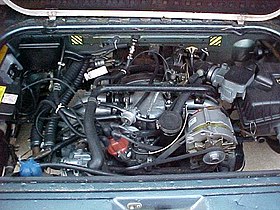This article relies largely or entirely on a single source. (November 2009) |
| Volkswagen wasserboxer | |
|---|---|
 | |
| Overview | |
| Manufacturer | Volkswagen Group |
| Production | August 1982 – July 1992[1] |
| Layout | |
| Configuration | flat-4 petrol engine |
| Displacement | 1,914 cc (116.8 cu in), 2,109 cc (128.7 cu in) |
| Cylinder bore | 94 mm (3.70 in)[1] |
| Piston stroke | 69 mm (2.72 in) 76 mm (2.99 in) |
| Cylinder block material | Cast aluminium alloy |
| Cylinder head material | Cast aluminium alloy |
| Valvetrain | pushrod OHV |
| Combustion | |
| Fuel system | carburettor / Electronic Fuel Injection |
| Fuel type | Petrol/gasoline |
| Oil system | Wet sump |
| Cooling system | Water-cooled |
| Chronology | |
| Predecessor | Volkswagen air-cooled engine |
The Volkswagen wasserboxer is a four cylinder horizontally opposed pushrod overhead-valve (OHV) petrol engine developed by Volkswagen. The engine is water-cooled, and takes its name from the German: "Wasserboxer" ("water-boxer"); with "boxer" being another term for horizontally opposed engines. It was available in two displacements – either a 1.9-litre[1] or a 2.1-litre;[1] the 2.1-litre being a longer-stroke version of the 1.9-litre, both variants sharing the same cylinder bore.[1] This engine was unique to the Volkswagen Type 2 (T3) (Transporter T3 / Caravelle / Vanagon / T25), having never been used in any other vehicle.[1] Volkswagen contracted Oettinger to develop a six-cylinder version of this engine. Volkswagen decided not to use it, but Oettinger sold a Volkswagen Type 2 (T3) equipped with this engine.[2]
